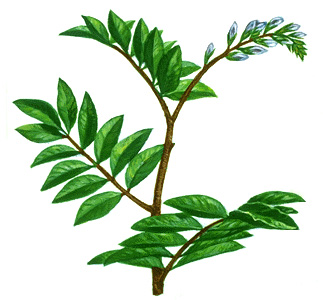Licorice << LIHK uhr ihs, LIHK rihs, LIHK uhr ihsh, or LIHK rihsh >> is an herb that contains both a valuable flavoring and compounds of medicinal value. Its flavoring comes from the herb’s long, sweet roots and rhizomes (root stems). The roots and rhizomes contain a compound, called glycyrrhizin, which is about 50 times as sweet as sugar. Licorice is a perennial–that is, it lives for more than one growing season.

Licorice is a native of southern Europe and parts of Asia. The plant grows to about 41/2 feet (1.4 meters) tall and has dark green leaves. It may be grown from seeds or from cuttings of rhizomes or stolons (stems that grow along the ground and take root).
Licorice extracts are used to flavor tobaccos, cigars, cigarettes, soft drinks, and alcoholic beverages. It also serves as a natural sweetener in candy and chewing gum. Licorice extract has traditionally been used to flavor medicines and cough mixtures.
The root fibers remaining after the licorice is extracted are used in making a fire-fighting foam, insulation board, and other products. Commercial licorice is brownish and black and is made by boiling the roots and rhizomes to produce a vapor, then cooling the vapor. It is added to licorice candy to provide the traditional black color and sweetness. The licorice flavor, however, actually comes from anethole, a compound found in anise, fennel, and other herbs.
